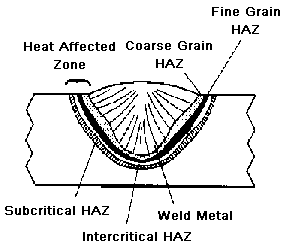
مهندسان جوش ( welding engineers )
جوشکاری یا عیب
مهندسان جوش ( welding engineers )
جوشکاری یا عیبWelding Steel Alloys
Welding Steel Alloys
Steel Alloys can be divided into five groups
Steels are readily available in various product forms. To establish a proper welding procedure it is necessary to know the material properties of the steel being welded. The American Iron and Steel Institute defines carbon steel as follows: |
Steel is considered to be carbon steel when no minimum content is specified or required for chromium, cobalt, columbium [niobium], molybdenum, nickel, titanium, tungsten, vanadium or zirconium, or any other element to be added to obtain a desired alloying effect; when the specified minimum for copper does not exceed 0.40 per cent; or when the maximum content specified for any of the following elements does not exceed the percentages noted: manganese 1.65, silicon 0.60, copper 0.60. Carbon steels are normally classified as shown below.
Low-carbon steels contain up to 0.30 weight percent C. The largest category of this class of steel is flat-rolled products (sheet or strip) usually in the cold-rolled and annealed condition. The carbon content for these high-formability steels is very low, less than 0.10 weight percent C, with up to 0.4 weight percent Mn. For rolled steel structural plates and sections, the carbon content may be increased to approximately 0.30 weight percent, with higher manganese up to 1.5 weight percent.
Medium-carbon steels are similar to low-carbon steels except that the carbon ranges from 0.30 to 0.60 weight percent and the manganese from 0.60 to 1.65 weight percent. Increasing the carbon content to approximately 0.5 weight percent with an accompanying increase in manganese allows medium-carbon steels to be used in the quenched and tempered condition.
High-carbon steels contain from 0.60 to 1.00 weight percent C with manganese contents ranging from 0.30 to 0.90 weight percent.
High-strength low-alloy (HSLA) steels, or microalloyed steels, are designed to provide better mechanical properties than conventional carbon steels. They are designed to meet specific mechanical properties rather than a chemical composition. The chemical composition of a specific HSLA steel may vary for different product thickness to meet mechanical property requirements. The HSLA steels have low carbon contents (0.50 to ~0.25 weight percent C) in order to produce adequate formability and weldability, and they have manganese contents up to 2.0 weight percent. Small quantities of chromium, nickel, molybdenum, copper, nitrogen, vanadium, niobium, titanium, and zirconium are used in various combinations.
Below are some typical welding considerations when welding carbon and low alloy steels
- Carbon Equivalent of the Steel
- Weld Cooling Rates
- Solidification Cracking
- Reheat Cracking
- Lamellar Tearing
- Hydrogen Cracking
If your company is experiencing these or other welding problems you can retain AMC to improve your weld processing. Hire AMC to act as your welding specialist.



























